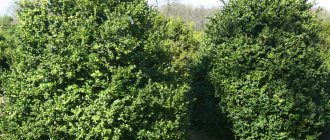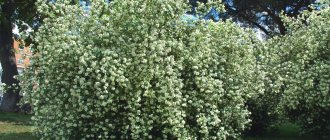Natalya Popova I’ll tell you about the varieties and care of willow
Purple willow pendula is a woody plant of the Willow family. Grows throughout Russia. The plant is planted in squares, parks, private gardens, on personal plots, and near open reservoirs. Other common names for willow are broom, vine, willow, willow, willow, shelyuga. I’ll tell you about the varieties, cultivation and care of willow.
Willow trees have a well-developed root system. Therefore, they are often planted to strengthen loose and sandy soils.
Description of purple willow
Due to its unpretentiousness and ease of maintenance, the culture is popular among both professional landscape designers and amateur gardeners. Purple willow is used to improve public gardens, garden plots, alleys and city parks.
The plant is a spherical bush up to 4 meters in height with thin flexible branches of a reddish hue. The leaves are oblong, pointed, 14-15 cm long, and can be of different colors and shades: from silver to light purple. Flowering begins at the same time as the leaves bloom. The willow got its name from the flowering purple catkins.
Our advantages
12 years on the market
Over the course of 12 years of successful work, we continue to delight our customers with beautiful and healthy plants.
15,000 plant varieties
We offer over 15,000 varieties of seedlings available for regular sale
Better conditions
We offer our own plants at the manufacturer's price with maximum survival rate
Delivery
Daily in-house delivery of plants throughout Moscow and the Moscow region. We ship throughout Russia
We are close
Our plant nursery is located in the northeast of Moscow near the Moscow Ring Road
Exclusive plants
Our assortment includes exclusive plants that only we have
Types and varieties
In nature, there are more than 150 varieties of purple willow. The recognizable and unusual appearance attracted the attention of breeders, who worked hard and bred more than one variety with a decorative crown. As a result, shrubs are widely used for landscaping streets and courtyards.
Nana
A neat bush, no more than one and a half meters tall, with a dense spherical top of the same size. The branches are thin and flexible, reddish in color. The leaves are elongated, silver-green in color. The root system is spreading, so coastal areas of reservoirs are strengthened with willow. It tolerates frost and winter well; no shelter is required.
Pendula
The plant has an elegant original crown of a cascading shape, with branches descending to the ground. The variety is distinguished by thin and flexible shoots of a purple hue. It grows up to 1.5 meters and has light green or light green leaves. The shrub is equally resistant to frost and drought.
Weeping
The main difference is the large size. The height can reach up to 3 m, and the width of the crown can be 4-5 m. The dense foliage is painted in a bright green bluish color. The shoots fall to the very bottom, so the tree looks sad, which is why it got its name. Requires a lot of free space.
Gracilis
The low-growing spherical bush does not grow above one meter. It has graceful twigs and small leaves of a light emerald hue. The bush resembles an elegant cloud. Due to its neatness, it is used in decorating local areas.
Lighthouse
Willow with erect long branches that point upward. Developed by Ural scientists for weaving household products (baskets, cradles, chests, tables, chairs). It looks very unusual in street decoration.
Nothing extra
It is recommended to start pruning a tree from the first year of life. All shoots are cut off, leaving only 15 cm and one healthy bud, which should look up. This is the beginning of the formation of a regular and beautiful willow crown. Mature trees also need pruning, but do this after flowering. To make the willow thick, all shoots are shortened by 2/3 of the total length. Do not forget that all dry and diseased branches are removed immediately. As a result, you should have a tent-shaped tree with strong, healthy and beautiful shoots.
For proper and timely care, willow will thank you with its amazing flowering. It is worth fighting not only with branches, but also with diseases and various pests.
Planting and caring for the plant
When planting a plant, certain rules must be taken into account.
Planting rules
The plant should be planted when the night and day temperature changes end. Choose a bright place, but partial shade is also suitable. If there is strong shading, the branches will begin to reach towards the bright light, which will not be very aesthetically pleasing. If the tree grows as a single crop, then it is not necessary to dig up the soil. But if it is a hedge, you need to dig a trench. For each seedling, you need to make separate holes 0.5 m wide and about 0.4 m deep. It is advisable to maintain a decent distance between them so that upon reaching adulthood they do not interfere with each other’s growth.
Purple willow germinates in any soil, but prefers neutral acidity. If necessary, drainage made of pebbles and broken bricks is laid at the bottom of the hole. A seedling is placed in a hole previously filled with water and covered with a mixture of soil with peat, compost, sand and nitrogen-containing fertilizers. Then water again generously with warm water. It is important to note that young trees should not be planted next to walnut or birch. Such a neighborhood can have a negative impact on development.
Watering and fertilizing
Willows are very moisture-loving. Therefore, if there is a body of water nearby, this is an ideal place for planting. This will reduce the frequency of watering. Otherwise, the tree needs regular moistening, and not only the roots, but also the foliage. Irrigation is preferable before sunrise or after sunset, so that moisture does not evaporate under its rays. After watering, you need to loosen the soil around the seedling for better access of oxygen to the roots. To maintain moisture longer, mulch with peat.
Feeding is advisable several times a season, to which the purple willow will gratefully respond with rapid development. Complex mineral fertilizers are applied in spring and summer, and phosphorus-potassium fertilizers are applied in autumn. With slow maturation, you can use nitroammophoska. It will help the bush create a lush green head.
Although it is frost-resistant, in the first years it is recommended to cover it with sackcloth or agrofibre for the winter.
Do you use willow trees in your landscaping?
Yes
No
Anti-aging pruning
To add decorative value and in order to preserve and improve health, the willow is pruned. The procedure can begin from the second or third year of life. The crown is formed in the spring and only after flowering has ended. She tolerates haircuts well and recovers very quickly. Without pruning, the crown loses its shape and charm. The formed plant is tidied up every spring, removing old and dried flowers and branches or new ones that have grown out of place. It is important to disinfect the sections. The number of deleted branches should not exceed 50%. Sanitary pruning is used to keep the purple willow in a healthy state - a crown that is too thick is thinned out to allow for more air and light.
Using a knife, cut rods 15-20 cm long, and there should be 5-7 buds on them. The lower cutting angle should be at an angle of 45°. You can germinate twigs at home on a windowsill by placing them in a container of water. Some gardeners place them in wet sand, provided that 2-3 buds are above the surface. It is necessary to monitor the moisture content of the sand. There is no need to rush to transfer the workpieces into open ground; it is better to wait until the root system of the young plants gets stronger.
Purple willow propagation
The predominant method of propagation is cuttings. You can get a plant from seeds, but this process is incredibly troublesome, since after ripening they are ready to produce offspring within only 10 days. Very small percentage of germination. After flowering, the seeds ripen for a month and can be collected in late spring - early summer. They are germinated in greenhouses, periodically moistening the soil, since drying out is contraindicated. When several leaves appear, you can remove the shelter. After the sprout reaches 5 cm, it can be transplanted into open ground, but no later than September, before the first frost.
Cuttings are harvested before the spring growing season, which is accompanied by powerful sap flow. To do this, take strong specimens over two years old.
With proper care and following recommendations, it is rarely affected by diseases and pests, but the invasion of weevils, aphids and leaf beetles cannot be ruled out. As well as rust or powdery mildew disease. The latter is manifested by a whitish coating on the foliage. If during humid weather the leaves turn black and begin to die, this is scab. Fungicides are used for treatment. The appearance of yellow specks is rust. Diseased parts are removed and burned. In the fight against insect pests, Bordeaux mixture and insecticides are used, sparrows and bats also help, or the larvae are collected by hand.
Reproduction
A healthy, undamaged seedling is the guarantee that the tree will quickly take root and will not get sick in a new place. Willow propagation occurs in two ways:
| Method 1. Grafting onto a standard The height of the tree will depend on the location of the grafting:
| |
Method 2. Propagation by cuttings
|
When purchasing a seedling grown on a trunk, you should carefully inspect the trunk. It should be healthy, smooth, without visible damage and dead or drying areas.
Purple willow in landscape design
Willows are so diverse that they can be incorporated into all kinds of landscape compositions. One of the benefits of wood is early awakening. In summer it pleases the eye with various shades of foliage, and in winter with the beautiful color of the branches from brown to dark olive against a background of white snow.
Due to its ability to hold the soil together, it is often planted on the banks of rivers, lakes, ponds and in swampy areas. Due to the easy transferability of pruning, designers often use it to create various shapes in decoration (geometric, animal images, bonsai). Using pruners, you can create a variety of shapes. Living fences and hedges are built from it. With its help you can level out an unsightly part of your garden plot. Purple willow harmonizes with flowers, grass, and conifers.
Growing willow will bring great pleasure, as it will reciprocate its gratitude in the form of active growth and lovely flowering. And landscape compositions will surprise and delight with their pomp for a long time.
Selection of planting material
When you arrive at the nursery, you should know exactly what to look for in order to buy a tree such as Pendula goat willow. Planting and care will depend directly on the quality of the seedlings. We invite you to review our following tips:
Tip 1. Find out how the shoot was obtained. Today there are two main methods:
- pruning;
- graft.
Using this information, you can plan further tree care.
Tip 2. If the second method was used, carefully inspect the grafting site. There should be no dead scales on the bark. The trunk must be straight and strong.
Tip 3. Buy only goat willow that has increased winter hardiness.
These simple recommendations will help you buy the right and healthy plant, such as goat willow Pendula. Planting and care are the next important steps.
Notes
- For the convention of indicating the class of dicotyledons as a superior taxon for the group of plants described in this article, see the section “APG Systems” of the article “Dicotyledons”.
- Yellowberry // Encyclopedic Dictionary of Brockhaus and Efron: in 86 volumes (82 volumes and 4 additional). - St. Petersburg, 1890-1907.
- [www.missouribotanicalgarden.org/PlantFinder/PlantFinderDetails.aspx?kempercode=f420 Salix purpurea 'Nana']. Missouri Botanical Garden. Retrieved September 7, 2014.
- [plants.bachmanslandscaping.com/12070012/Plant/1392/Arctic_Blue_Leaf_Willow Arctic Blue Leaf Willow]. Bachman's Landscaping Plant Library. Retrieved September 7, 2014.
Literature
Wikisource has texts on the topic Salix purpurea
- [herba.msu.ru/shipunov/school/books/flora_sssr1936_5.djvu Genus 356. Willow - Salix L.] // Flora of the USSR: in 30 volumes / ch. ed. V. L. Komarov. — M.—L. : Publishing House of the USSR Academy of Sciences, 1936. - T. V / ed. volumes V. L. Komarov. - P. 169. - 762 + XXVI pp. — 5175 copies.
- Genus 2. Willow - Salix L. // [herba.msu.ru/shipunov/school/books/der_i_kust_sssr1951_2.djvu Trees and shrubs of the USSR. Wild, cultivated and promising for introduction.] / Ed. volumes S. Ya. Sokolov. - M.-L.: Publishing House of the USSR Academy of Sciences, 1951. - T. II. Angiosperms. — P. 156-157. — 612 s. — 2500 copies.











